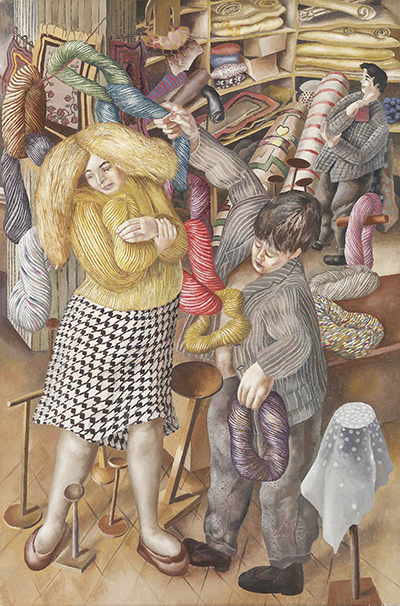In one of his more detailed and narrative pieces, Stanley Spencer seems to be cramming in all his feelings and thoughts, in a bid to understand his own motivations or attractions, it seems. The Woolshop is, superficially, a deceptively domestic scene.
A woman is buying some wool, and is aiming to match the wool she buys with her jumper – a common and still relevant motif of anyone who knits often as a slight colour variation between dye lots can result in jumpers and scarfs with patches of lighter or darker colour. The assistant, business-like in a suit which is a somewhat drab contrast with the cheerful mustard yellow that is not only the desired shade, but also seems to match the woman's exuberant hair which is thick and unruly, falling to just beyond her shoulders – a statement of glorious womanhood, perhaps.
The wool shop in question is more of a haberdashery or fabric shop with skeins of wool nestling alongside disordered bolts of fabric, drifts of lace and even small bedside rugs all on somewhat hectic display in the background. A third figure is seated at leisure, seemingly gazing into space, as though it would be unmanly to pay too much attention to these purely feminine concerns.
And yet, that third figure is a representation of the artist, Spencer himself, and the blonde woman who is seemingly so focussed on her choice of wool can also be seen to be posing for him, twisting her body contrapposto in such as way as to enhance her figure and beguile him. And beguiled he was. The woman in the painting is known to be Daphne Charlton, wife of George Charlton, and both artists with whom Spencer was staying following the breakdown of his second and highly unorthodox marriage. At the time of painting, Spencer and Daphne were going through a period of pre-seduction fascination with each other, and this is clear from the way the female form catches the eye and seems to be so innocently alluring.
Spencer possibly painted the picture to root Daphne firmly in domesticity – her current marriage which was, by all accounts, a happy one as far as he knew – seeing her happy and content, in her element, while he, distant artist must be content to simply observe and admire. In fact, Spencer and Daphne did, in fact, have an affair, with the seeming blessing of George, to whom Daphne remained happily married. It seems the Charlton's marriage was unconventional and yet a good match with the feisty young woman and the experienced older man proving equal – and rather open – partners. This painting is not currently on display but is in the hands of the Tate Gallery. It is in oil paint on canvas.




